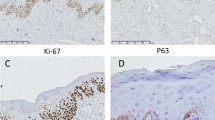Abstract
Oral leukoplakia and other potentially malignant disorders (PMD) may progress to oral squamous cell carcinoma (OSCC). The gold standard for assessing the potential for malignant transformation remains histologic examination with the aim of grading the dysplastic changes. However, not all lesions with dysplasia will progress to OSCC. DNA ploidy has been suggested as a method to predict the clinical behaviour of PMD. This study reports on the use of high-resolution flow cytometry to determine the ploidy status of formalin-fixed, paraffin-embedded material from PMD compared to their dysplasia grade on histology. Aneuploidy was found in 13 % of mild, 31 % of moderate, and 54 % of severe dysplasia cases. This difference was statistically significant (p = 0.011). The differences in ploidy status were more significant when grouping the dysplasia into low-risk and high-risk categories (p = 0.008). These findings indicate that the ploidy status of PMD as determined by high-resolution flow cytometry may be of value in predicting biological behaviour in PMD such as leukoplakia.




Similar content being viewed by others
References
Warnakulasuriya S, Reibel J, Bouquot J, Dabelsteen E. Oral epithelial dysplasia classification systems: predictive value, utility, weaknesses and scope for improvement. J Oral Pathol Med. 2008;37(3):127–33.
Napier SS, Speight PM. Natural history of potentially malignant oral lesions and conditions: an overview of the literature. J Oral Pathol Med. 2008;37(1):1–10.
Holmstrup P, Vedtofte P, Reibel J, Stoltze K. Long-term treatment outcome of oral premalignant lesions. Oral Oncol. 2006;42(5):461–74.
Silverman S Jr, Gorsky M, Lozada F. Oral leukoplakia and malignant transformation. A follow-up study of 257 patients. Cancer. 1984;53(3):563–8.
Eversole LR. Dysplasia of the upper aerodigestive tract squamous epithelium. Head Neck Pathol. 2009;3(1):63–8.
Khanna R, Agarwal A, Khanna S, Basu S, Khanna AK. S-phase fraction and DNA ploidy in oral leukoplakia. ANZ J Surg. 2010;80(7–8):548–51.
Islam MN, Kornberg L, Veenker E, Cohen DM, Bhattacharyya I. Anatomic site based ploidy analysis of oral premalignant lesions. Head Neck Pathol. 2010;4(1):10–4.
Donadini A, Maffei M, Cavallero A, Pentenero M, Malacarne D, Di Nallo E, et al. Oral cancer genesis and progression: DNA near-diploid aneuploidization and endoreduplication by high resolution flow cytometry. Cell Oncol. 2010;32(5–6):373–83.
Bradley G, Odell EW, Raphael S, Ho J, Le LW, Benchimol S, et al. Abnormal DNA content in oral epithelial dysplasia is associated with increased risk of progression to carcinoma. Br J Cancer. 2010;103(9):1432–42.
Torres-Rendon A, Stewart R, Craig GT, Wells M, Speight PM. DNA ploidy analysis by image cytometry helps to identify oral epithelial dysplasias with a high risk of malignant progression. Oral Oncol. 2009;45(6):468–73.
Pentenero M, Giaretti W, Navone R, Demurtas A, Rostan I, Bertolusso G, et al. DNA aneuploidy and dysplasia in oral potentially malignant disorders: association with cigarette smoking and site. Oral Oncol. 2009;45(10):887–90.
Bremmer JF, Brakenhoff RH, Broeckaert MA, Belien JA, Leemans CR, Bloemena E, et al. Prognostic value of DNA ploidy status in patients with oral leukoplakia. Oral Oncol. 2011;47(10):956–60.
Hemmer J, Van Heerden W, Raubenheimer E, Kreidler J, Schon E. Flow cytometric DNA ploidy and recurrence development in squamous cell carcinoma of the oral cavity. Int J Oncol. 1996;8(1):113–6.
Hemmer J, Thein T, Van Heerden WF. The value of DNA flow cytometry in predicting the development of lymph node metastasis and survival in patients with locally recurrent oral squamous cell carcinoma. Cancer. 1997;79(12):2309–13.
Hemmer J, Nagel E, Kraft K. DNA aneuploidy by flow cytometry is an independent prognostic factor in squamous cell carcinoma of the oral cavity. Anticancer Res. 1999;19(2B):1419–22.
Van Heerden WF, Raubenheimer EJ, Dreyer L. The role of DNA ploidy and Ki-67 in the grading of mucoepidermoid carcinomas. Anticancer Res. 2005;25(3c):2589–92.
World Health Organization Classification of Tumours. Pathology & genetics. Head and neck tumours. Lyon: International Agency for Research on Cancer (IARC) IARC Press; 2005.
Heiden T, Wang N, Tribukait B. An improved Hedley method for preparation of paraffin-embedded tissues for flow cytometric analysis of ploidy and S-phase. Cytometry. 1991;12(7):614–21.
Hemmer J, Kraft K. High-resolution DNA flow cytometry in oral verrucous carcinoma. Oncol Rep. 2000;7(2):433–5.
Hemmer J, Kreidler J. Flow cytometric DNA ploidy analysis of squamous cell carcinoma of the oral cavity. Comparison with clinical staging and histologic grading. Cancer. 1990;66(2):317–20.
Kujan O, Oliver RJ, Khattab A, Roberts SA, Thakker N, Sloan P. Evaluation of a new binary system of grading oral epithelial dysplasia for prediction of malignant transformation. Oral Oncol. 2006;42(10):987–93.
Hemmer J, Schon E. Cytogenetic progression and prognosis in oral-carcinoma—a DNA flow cytometric study on 317 cases. Int J Oncol. 1993;3(4):635–40.
Speight PM. Update on oral epithelial dysplasia and progression to cancer. Head Neck Pathol. 2007;1(1):61–6.
Acknowledgments
The authors would like to thank Prof Sonja Boy who participated with the histological grading and the National Research Foundation of South Africa for financial support.
Author information
Authors and Affiliations
Corresponding author
Rights and permissions
About this article
Cite this article
van Zyl, A.W., van Heerden, M.B., Langenegger, E. et al. Correlation Between Dysplasia and Ploidy Status in Oral Leukoplakia. Head and Neck Pathol 6, 322–327 (2012). https://doi.org/10.1007/s12105-012-0352-9
Received:
Accepted:
Published:
Issue Date:
DOI: https://doi.org/10.1007/s12105-012-0352-9




